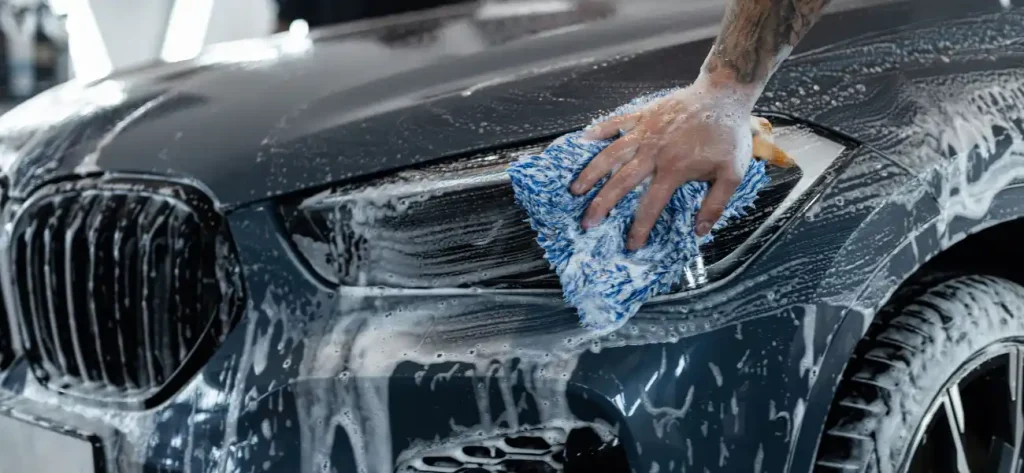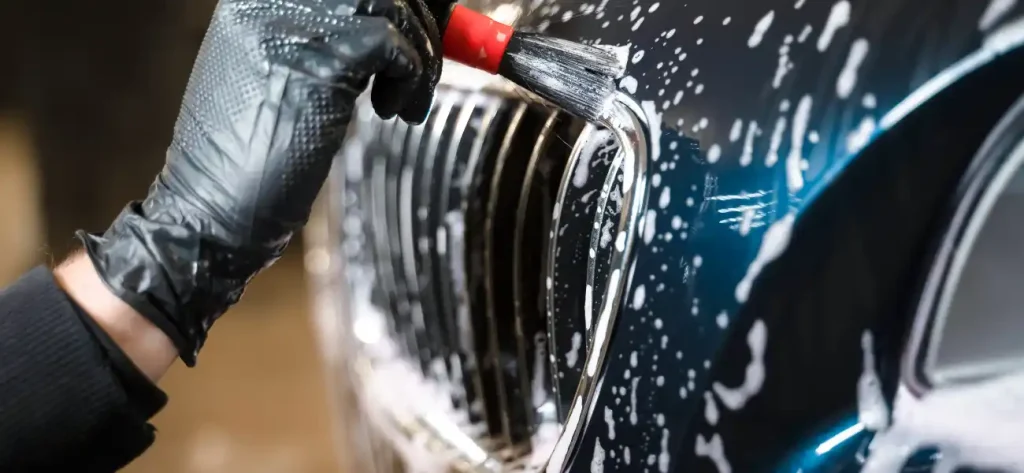A car wash in Toronto Downtown, is like a quick, basic shower for your car that mostly cleans the easy-to-reach dirt and dust from the outside using water and soap.
On the other hand, car detailing is like a “spa day” for your car, where a special person called a detailer gives it a super-deep cleaning both inside and out.
Using special tools like a vacuum and tiny brushes to clean every small space like the air vents and polishing the paint with wax to make it look brand new and stay protected for much longer.
What is a Car Wash?
A car wash is a quick and simple process for cleaning the outside of your car, much like giving your favorite toy a fast rinse when it gets dirty. The main goal is to wash away easy-to-see things like dirt, dust, and mud that pile up from everyday driving.
This is usually done by driving the vehicle through a machine with big, soft brushes and lots of bubbly soap and water, or by washing it quickly with a hose and sponge at home.
It’s an easy way to keep your car looking neat and protect the paint from getting damaged by the outdoor mess.
The Auto Cleaning Steps involve:
Pre-Rinse/Pre-Wash: Applying high-pressure water to remove loose dirt, dust, and debris before soaping, which helps prevent surface scratches. This may also include a specialized chemical pre-soak or degreaser application for heavy soil or bug/tar removal, particularly on lower panels and wheels.
Soap Application (Main Wash): Applying specially formulated car wash soap or foam, often via soft brushes, cloths, or a touchless high-pressure system, to break down and lift embedded dirt and grime from the paint.
Washing/Agitation: Gently scrubbing the vehicle’s surface with soft brushes, mitts, or cloth strips (in automatic washes) or a hand mitt (in hand washes) to ensure thorough cleaning.
High-Pressure Rinse: Rinsing the car thoroughly with clean water to completely remove all soap residue and suspended dirt particles.
Protective Treatment (Optional): Applying surface treatments like wax, polish, or a clear coat protectant to enhance shine and provide a barrier against the elements.
Final Rinse (Spot-Free): Using deionized or filtered water for the final rinse to minimize water spots left behind as the car dries.
Drying: Removing excess water using air blowers, a water blade, or clean microfiber towels/chamois to prevent streaks and water spots.
Tire and Wheel Treatment (Optional): Cleaning and applying a dressing or shine product specifically to the tires and wheels.
Interior Cleaning (Full-Service Option): Often includes vacuuming the carpets and seats, wiping down the dashboard and console, and cleaning interior windows.

What is Auto Detailing?
Auto detailing is a comprehensive, meticulous process of thoroughly cleaning, restoring, and finishing a motor vehicle, both inside and out, to produce a show-quality level of cleanliness and polish.
It goes far beyond a regular car wash, which is a surface-level cleaning. Detailing is a methodical, multi-step maintenance service that involves specialized tools, high-quality chemical products, and techniques to remove visible and non-visible contaminants.
Correct paint defects (like swirl marks and light scratches), and apply protective coatings to preserve the vehicle’s condition and enhance its value.
Essentially, it aims to return the car to a “like-new” state, focusing on the finer, hard-to-reach areas and the overall restoration of all surfaces.
Steps in the Auto Detailing Process
Auto detailing is typically divided into two main components: Exterior Detailing and Interior Detailing. While packages vary, a full detail usually follows these general, meticulous steps:
Exterior Detailing Process
- Wheels and Tires First: Thoroughly clean the wheels, tires, and wheel wells using dedicated, often acidic or iron-removing, cleaners to eliminate brake dust, road grime, and fallout. This is done first as it’s the dirtiest area, preventing the contamination from splashing onto the clean car body later.
- Pre-Wash and Foam Soak: Rinse the entire vehicle with water to remove loose dirt. Apply a “snow foam” or pre-wash solution to the whole body and allow it to dwell, chemically loosening and encapsulating embedded dirt before physical contact.
- Contact Wash: Perform a gentle hand wash using a pH-neutral car shampoo and a soft wash mitt, typically employing the two-bucket method (one bucket for soapy water, one for rinsing the mitt) to prevent transferring grit back to the paint.
- Decontamination (Clay Bar Treatment): After washing, use a chemical fallout remover spray (iron remover) and/or a clay bar with a lubricating spray to safely lift and remove bonded contaminants from the paint surface (e.g., tree sap, industrial fallout, rail dust) that washing alone cannot remove.
- Drying: Thoroughly dry the vehicle using a dedicated microfiber drying towel, chamois, or compressed air/blower to prevent water spots.
- Paint Correction (Polishing): This is a critical detailing step where abrasive polishes and buffers are used to remove a microscopic layer of the clear coat, eliminating swirl marks, oxidation, hazing, and light scratches. This restores the paint’s deep shine and clarity.
- Protection (Waxing/Sealing/Coating): Apply a final protective layer like natural carnauba wax, a synthetic sealant, or a high-durability ceramic coating to shield the paint from UV rays and environmental damage while significantly boosting gloss.
- Trim and Glass: Clean and condition exterior plastic and rubber trim to restore color and protect against fading. Clean all exterior glass with a streak-free cleaner.

Interior Detailing Process
- Trash Removal and Initial Vacuum: Remove all trash and personal items. Thoroughly vacuum all carpets, seats, and the trunk, using various attachments to reach crevices.
- Deep Cleaning Surfaces: Clean and treat all hard surfaces (dashboard, center console, door panels, cup holders, air vents) with specialized, non-greasy cleaners and compressed air/detail brushes to remove dust, dirt, and oils.
- Upholstery and Carpet Shampooing: Shampoo, steam clean, or use a hot water extractor on carpets, fabric seats, and floor mats to lift embedded dirt, debris, and stains.
- Leather Cleaning and Conditioning: Clean leather surfaces with a pH-neutral cleaner, then apply a leather conditioner to nourish, protect, and prevent cracking or fading.
- Headliner and Visors: Carefully clean the ceiling fabric (headliner) and sun visors, avoiding excessive moisture.
- Interior Glass: Clean all interior windows, including the rearview mirror, with a streak-free glass cleaner.
- Final Touches: Apply a protectant or dressing to plastic and vinyl surfaces (avoiding the steering wheel and pedals for safety).
Primary Difference Between Auto Wash and Vehicle Detailing
The primary difference between a Car Wash and Auto Detailing lies in the scope, depth, and purpose of the service.
A car wash is a fast, surface-level cleaning for routine maintenance, whereas auto detailing is a meticulous, comprehensive restoration process focused on deep cleaning, correction, and long-term protection. Here is a breakdown of the key differences:
- Car Wash
- Quick removal of surface dirt, dust, and grime for basic cleanliness.
- Primarily Exterior cleaning. Minimal or optional interior vacuuming/wipe-down.
- Surface-level cleaning only. Leaves behind embedded contaminants and deep stains.
- Basic soap and water wash (automated brushes or manual). May include a spray-on wax that offers minimal protection.
- Basic vacuuming of floors and seats; quick wipe of the dashboard.
- Quick: Typically 10 to 45 minutes.
- Low: Budget-friendly for frequent maintenance.
- Frequent: Recommended weekly or bi-weekly.
- A clean car that looks presentable.
- Auto Detailing
- Deep cleaning, restoration, and protection to achieve a “like-new” condition.
- Comprehensive cleaning, restoration, and protection for both the entire interior and exterior.
- In-depth, meticulous cleaning that targets every crack, crevice, and component.
- Multi-step process including a hand wash, clay bar treatment (to remove embedded contaminants), polishing (to correct paint defects like swirl marks), and the application of long-lasting wax, sealant, or ceramic coating.
- Deep cleaning of all surfaces. Includes shampooing carpets and upholstery, steam cleaning, leather conditioning, meticulous cleaning of vents, cup holders, and door panels.
- Time-Intensive: Typically 2 to 8 hours, depending on the service package and vehicle condition.
- High: More expensive due to the extensive labor, time, specialized expertise, and premium products involved.
- Periodic: Recommended every 4 to 12 months, or as needed for restoration.
- A restored car with enhanced shine, corrected paint, protected surfaces, and improved long-term value.
Conclusion: Car Wash vs. Auto Detailing
In essence, the choice between a car wash and auto detailing is a matter of depth and purpose. A car wash is an excellent option for routine, surface-level maintenance—a quick, affordable method to remove daily dirt and keep the vehicle presentable.
Auto detailing, however, is a comprehensive, multi-step restoration process. It goes beyond cleaning by correcting paint defects, meticulously sanitizing every crevice of the interior, and applying long-lasting protective coatings.








